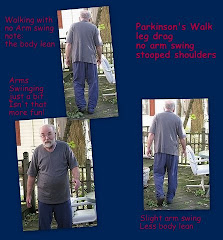Optogenics and the G-protein coupled receptor - what will it mean for PD?
 It all begins in the brain, that complicated computer which processes analyzes, sorts, stores, and relays electrical impulses to keep the body functioning as designed. Sometimes, however, things go wrong, small parts malfunction, current varies to affect operation and the body human begins to get error messages. On many occasions we reboot, clean up some programs, add a program and we're good to go. Or we call IT or MIS and those specialists can fix many problems. But at other times the error messages persist.
It all begins in the brain, that complicated computer which processes analyzes, sorts, stores, and relays electrical impulses to keep the body functioning as designed. Sometimes, however, things go wrong, small parts malfunction, current varies to affect operation and the body human begins to get error messages. On many occasions we reboot, clean up some programs, add a program and we're good to go. Or we call IT or MIS and those specialists can fix many problems. But at other times the error messages persist.
Parkinson's disease sends some of those errors messages. The specialists here have been able to take patients to the edge of state of the art with medications which abate progression, which go to the source to make some symptoms ease or stop for awhile, but the disease remains. New treatments were developed to control the symptoms by interrupting the error messages. From radical surgery to invasive but less radical surgery, some patients have found relief while others were the same or worse.
We already know that not all PD patients are eligible for Deep Brain Stimulation (DBS) and that it appears to be effective for some but not all of the people who do receive the treatment. Ongoing research in an area called optogenics may become a way to change some of that situation by employing a method which allows for more precision in the surgical procedure by prior identification of the neurons which would benefit from stimulation. Basically the focus become tighter and more accurate before the nodes are set. One goal is to improve the results of DBS.
While aspects of the area of science now called Optogenics have existed for several years, the older apects are now being combined with a method developed in Karl Deisseroth's lab. By inserting a small fiberoptic cable into the brain the light impulses can be controlled as they search for the affected neurons. This procedure allows for smaller and smaller targets of the G-protein on the specific neuron.
have existed for several years, the older apects are now being combined with a method developed in Karl Deisseroth's lab. By inserting a small fiberoptic cable into the brain the light impulses can be controlled as they search for the affected neurons. This procedure allows for smaller and smaller targets of the G-protein on the specific neuron.
The current procedures were developed by under the direction of Karl Deisseroth, MD, PhD at Stanford University. The project required the work of bioengineering and medical neuroscience and neurology students and faculty as they explored target after target to finally find that stimulation of the axons that connect the subthalmic nucleus are actually in areas closer to the brain's surface. While treatments would be still invasive, they would be less invasive thanks to better targeting at the G protein coupled receptors at the cell surface.
 At Stanford University scientists were able to incorporate the technique in model mouse brains to produce activity in a real-time frame using both blue light to signal activity and yellow light to stop. The cells returned to their normal status unchanged at completion.
At Stanford University scientists were able to incorporate the technique in model mouse brains to produce activity in a real-time frame using both blue light to signal activity and yellow light to stop. The cells returned to their normal status unchanged at completion.
An interesting thing about neurons is that they communicate in a manner similar to binary code. Sometimes on sometimes off similar to the 0s and 1s of binary code. By being able to communicate in their on-off patterns, learning the neuron language might enable direct actual neural instruction through the flashing of the blue and yellow lights. In another metaphor, Optogenics appears to be the cell tower, now what is needed is a phonebook.
Optogenics holds hope for spinal cord injuries, restoring function to paralyzed limbs, allowing for new therapies, closely targeted pharmaecuticals and possibly become a neuronal therapy in itself.
Optogenics: A process by which brain cells can be activated by specific light
Channel Rhodopsins (ChR): light-activated ion channels appear to be coupled with the photoreceptor so that they do not require chemical signalling but instead are triggered by light.
Channel Rhodopsin (ChR2): algae-derived gene protein which makes neurons more active upon blue light exposure. Currently vector-introduced to the desired neurons. This is the "emit a signal" protein
Halo-rhodopsin (NpHR): from a microbe which can make neurons less active. The instruction here is to "stop emitting." They respond to yellow light.
G protein coupled receptors (GPCRs): signalling proteins found on the surface of nearly all cells.
Reading List:
http://storybank.stanford.edu/stories/controlling-brain-with-optogenics
http://www.newscientist.com/article/dn16807
http://www.freepatentsonline.com/7488583.html
http://pubs.acs.org/cen/science/86/8612sci1.html
http://www2.hu-berlin.de/biologie/expbp/Homepage-new_10408.pdf
http://web.mit.edu/newsoffice/2007/brain-block.html
http://med.stanford.edu/news_releases/2009/march/deisseroth.html
http://storybank.stanford.edu/stories/neural-traffic-light-a-go-better-brain-research
http://www.medicalnewstoday.com/articles/143132.php
Targeting the Brain's GO pathway - 2010 It all begins in the brain, that complicated computer which processes analyzes, sorts, stores, and relays electrical impulses to keep the body functioning as designed. Sometimes, however, things go wrong, small parts malfunction, current varies to affect operation and the body human begins to get error messages. On many occasions we reboot, clean up some programs, add a program and we're good to go. Or we call IT or MIS and those specialists can fix many problems. But at other times the error messages persist.
It all begins in the brain, that complicated computer which processes analyzes, sorts, stores, and relays electrical impulses to keep the body functioning as designed. Sometimes, however, things go wrong, small parts malfunction, current varies to affect operation and the body human begins to get error messages. On many occasions we reboot, clean up some programs, add a program and we're good to go. Or we call IT or MIS and those specialists can fix many problems. But at other times the error messages persist.Parkinson's disease sends some of those errors messages. The specialists here have been able to take patients to the edge of state of the art with medications which abate progression, which go to the source to make some symptoms ease or stop for awhile, but the disease remains. New treatments were developed to control the symptoms by interrupting the error messages. From radical surgery to invasive but less radical surgery, some patients have found relief while others were the same or worse.
We already know that not all PD patients are eligible for Deep Brain Stimulation (DBS) and that it appears to be effective for some but not all of the people who do receive the treatment. Ongoing research in an area called optogenics may become a way to change some of that situation by employing a method which allows for more precision in the surgical procedure by prior identification of the neurons which would benefit from stimulation. Basically the focus become tighter and more accurate before the nodes are set. One goal is to improve the results of DBS.
While aspects of the area of science now called Optogenics
 have existed for several years, the older apects are now being combined with a method developed in Karl Deisseroth's lab. By inserting a small fiberoptic cable into the brain the light impulses can be controlled as they search for the affected neurons. This procedure allows for smaller and smaller targets of the G-protein on the specific neuron.
have existed for several years, the older apects are now being combined with a method developed in Karl Deisseroth's lab. By inserting a small fiberoptic cable into the brain the light impulses can be controlled as they search for the affected neurons. This procedure allows for smaller and smaller targets of the G-protein on the specific neuron.The current procedures were developed by under the direction of Karl Deisseroth, MD, PhD at Stanford University. The project required the work of bioengineering and medical neuroscience and neurology students and faculty as they explored target after target to finally find that stimulation of the axons that connect the subthalmic nucleus are actually in areas closer to the brain's surface. While treatments would be still invasive, they would be less invasive thanks to better targeting at the G protein coupled receptors at the cell surface.
 At Stanford University scientists were able to incorporate the technique in model mouse brains to produce activity in a real-time frame using both blue light to signal activity and yellow light to stop. The cells returned to their normal status unchanged at completion.
At Stanford University scientists were able to incorporate the technique in model mouse brains to produce activity in a real-time frame using both blue light to signal activity and yellow light to stop. The cells returned to their normal status unchanged at completion.An interesting thing about neurons is that they communicate in a manner similar to binary code. Sometimes on sometimes off similar to the 0s and 1s of binary code. By being able to communicate in their on-off patterns, learning the neuron language might enable direct actual neural instruction through the flashing of the blue and yellow lights. In another metaphor, Optogenics appears to be the cell tower, now what is needed is a phonebook.
Optogenics holds hope for spinal cord injuries, restoring function to paralyzed limbs, allowing for new therapies, closely targeted pharmaecuticals and possibly become a neuronal therapy in itself.
Optogenics: A process by which brain cells can be activated by specific light
Channel Rhodopsins (ChR): light-activated ion channels appear to be coupled with the photoreceptor so that they do not require chemical signalling but instead are triggered by light.
Channel Rhodopsin (ChR2): algae-derived gene protein which makes neurons more active upon blue light exposure. Currently vector-introduced to the desired neurons. This is the "emit a signal" protein
Halo-rhodopsin (NpHR): from a microbe which can make neurons less active. The instruction here is to "stop emitting." They respond to yellow light.
G protein coupled receptors (GPCRs): signalling proteins found on the surface of nearly all cells.
Reading List:
http://storybank.stanford.edu/stories/controlling-brain-with-optogenics
http://www.newscientist.com/article/dn16807
http://www.freepatentsonline.com/7488583.html
http://pubs.acs.org/cen/science/86/8612sci1.html
http://www2.hu-berlin.de/biologie/expbp/Homepage-new_10408.pdf
http://web.mit.edu/newsoffice/2007/brain-block.html
http://med.stanford.edu/news_releases/2009/march/deisseroth.html
http://storybank.stanford.edu/stories/neural-traffic-light-a-go-better-brain-research
http://www.medicalnewstoday.com/articles/143132.php
In 2014 a small clinical trial for use of CBD oil for seizure disorders was published. It is referenced because of the explanation of the G-protein.
You can now find numerous optogenics studies.
You might also enjoy this article about Karl Deisseroth
2015 Optogenics study: Illuminating Parkinson's Therapy with Optogenics














No comments:
Post a Comment
Welcome to Parkinsons Focus Today.
We are delighted to hear from you by comment here
or through email as found in Contact Us.
Please do not include email addresses if leaving a comment online.
Email addresses are used only for email responses.
Spammers take note: your messages will not be published. The comments section is for an exchange of ideas, not for backlinks.